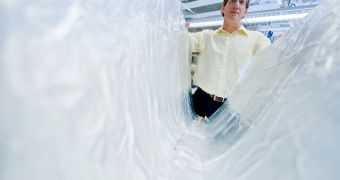A new water disinfection technique developed by experts in the United States could be used to quench the thirst of more than 800 million people around the planet, who currently do not have access to clean water sources. The method was developed at the Purdue University, in Indiana.
The prototype water-disinfection system researchers here created is capable of using the ultraviolet (UV) component in sunlight to clear the water of contaminants and water-borne pathogens. A parabolic reflector and a UV-transparent pipe are all that's needed.
The parabolic dish focuses light from the Sun in an intense beam, which is then shone on the pipe. The latter lets the UV component of light pass through, essentially sterilizing the water that flows continuously through the treatment pipe.
Such a practical, inexpensive water-treatment technology has been under development for decades, as scientists struggled to find a way to ensure safe access to clean water for a large portion of the world's population. These people mostly live in Third World or developing countries.
“More than 800 million people lack access to what we consider to be 'improved' water. The water available for people to drink in many developing countries hasn't been treated to remove contaminants, including pathogenic microorganisms,” Ernest R. Blatchley III explains.
“As a result, thousands of children die daily from diarrhea and its consequences, including dehydration. Half of the world's hospital beds are occupied by people who are sickened by the water they drink,” explains the scientist, a Purdue civil engineering professor.
He explains that the university team has been working on finding a way to use UV as a disinfection tool for about 20 years. It was only a couple of years ago that the group was able to refine its technology to such a point that it could use the Sun.
Before that, the method had to rely on artificial UV sources, which are very expensive, and require electricity. There is no way such an advanced technology could be deployed to the poorest, most remote villages of the Third World.
“It turns out that the solar radiation we receive in Indiana at some times of year is intense enough to inactivate some waterborne microorganisms with this type of system,” the team leader goes on to say.
“We demonstrated that we can disinfect water using sunlight. The reactor was very inexpensive to build, less than $100 for the materials,” Blatchley concludes.

 14 DAY TRIAL //
14 DAY TRIAL //